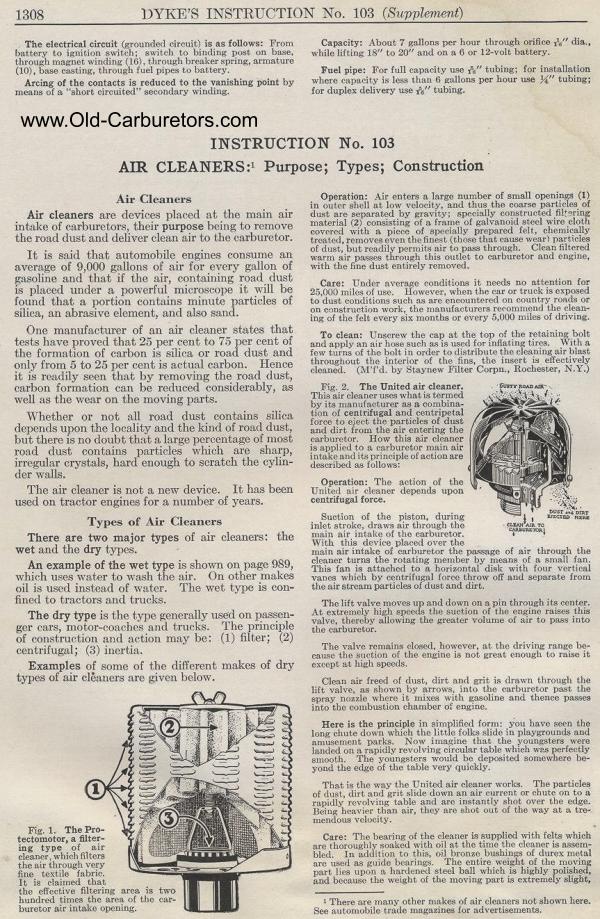Air Cleaners
The electrical circuit (grounded circuit) is as follows: From battery
to ignition switch; switch to binding post on base, through magnet
winding (16), through breaker spring, armature (10), base casting,
through fuel pipes to battery. Care: Under average conditions it needs no attention for 25,000 miles of use. However, when the car or truck is exposed to dust conditions such as are encountered on country roads or on construction work, the manufacturers recommend the cleaning of the felt every six months or every 5,000 miles of driving. To clean: Unscrew the cap at the top of the retaining bolt and apply an air hose such as is used for inflating tires. With a few turns of the bolt in order to distribute the cleaning air blast throughout the interior of the fins, the insert is effectively cleaned. (\I'f'd. by Staynew Filter Corpn., Rochester, N.Y.) Fig. 2. The United air cleaner. bus*r.o„...,w --This air cleaner uses what is termed by its manufacturer as a combination of centrifugal and centripetal force to eject the particles of dust and dirt from the air entering the carburetor. How this air cleaner is applied to a carburetor main air intake and its principle of action are described as follows: Operation: The action of the United air cleaner depends upon centrifugal force. Suction of the piston, during inlet stroke, draws air through
the main air intake of the carburetor. With this device placed
over the The lift valve moves up and down on a pin through its center. At extremely high speeds the suction of the engine raises this valve, thereby allowing the greater volume of air to pass into the carburetor. The valve remains closed, however, at the driving range be-cause the suction of the engine is not great enough to raise it except at high speeds. Clean air freed of dust, dirt and grit is drawn through the lift valve, as shown by arrows, into the carburetor past the spray nozzle where it mixes with gasoline and thence passes into the combustion chamber of engine. Here is the principle in simplified form: you have seen the long chute down which the little folks slide in playgrounds and amusement parks. Now imagine that the youngsters were landed on a rapidly revolving circular table which was perfectly smooth. The youngsters would be deposited somewhere beyond the edge of the table very quickly. That is the way the United air cleaner works. The particles of dust„ dirt and grit slide down an air current or chute on to a rapidly revolving table and are instantly shot over the edge. Being heavier than air, they are shot out of the way at a tremendous velocity. Care: The hearing of the cleaner is supplied with felts which
are thoroughly soaked with oil at the time the cleaner is assembled.
In addition to this, oil bronze bushings of durex metal are used
as guide bearings. The entire weight of the moving part lies upon
a hardened steel ball which is highly polished, and because the
weight of the moving part is extremely slight, Previous page 1927 Supplement Home Next page
|
